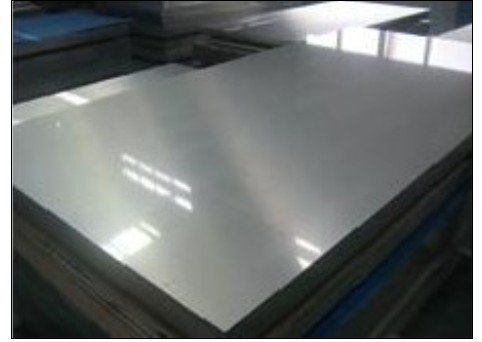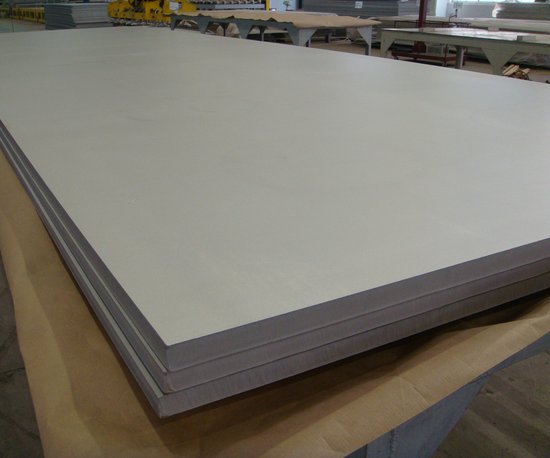Stainless Steel Sheets
- Loading Port:
- China Main Port
- Payment Terms:
- TT or LC
- Min Order Qty:
- 1 Ton m.t.
- Supply Capability:
- 3000 Tons Per Month m.t./month
OKorder Service Pledge
OKorder Financial Service
You Might Also Like
316L Stainless steel sheet
1. Chemical composition
|
C |
Si |
Mn |
P |
S |
Ni |
Cr |
|
Max0.03 |
max1.00 |
max2.00 |
max0.045 |
max0.03 |
10.00-14.00 |
16.00-18.00 |
2. Mechanical properties
|
Yield Strength |
Tensile |
Elongation |
Hardness (HV) |
Hardness (HRB) |
|
≥175 |
≥480 |
≥40 |
≤200 |
≤90 |
3. Standard: AISI, ASTM, GB, EN, DIN, JIS
4. Surface: 2B, NO.1, BA, NO.4, Hairline, SB, Mirror finish, Anti-skid, Cherkered etc.
5. Size: Thickness: 0.3-3mm (cold rolled), 3-40mm (hot rolled)
Width: 1000mm or 1219mm or 1240mm for cold rolled, 1500mm for hot rolled.
Length: As customers' request.
Length: As customers' request.
6. MOQ: 1 Ton
7. Payment terms: T/T or L/C
8. Packing: Seaworthy package with wooden or Iron pallets with the paper and the steel strip, or as customers' request.
9. Delivery time: Usually about 7 days after we confirming the order, or according to your quantity.
If you have any question or demand, pls feel free to contact me.


- Q:Are 111 stainless steel strips resistant to scaling at elevated temperatures?
- 111 stainless steel strips exhibit resistance to scaling at elevated temperatures. Due to its composition and properties, 111 stainless steel is highly resistant to oxidation and scaling when exposed to high temperatures. This stainless steel variant contains a greater proportion of chromium, which generates a protective oxide layer on the strip's surface. This oxide layer functions as a shield, inhibiting the steel from reacting with oxygen and other atmospheric elements. Consequently, the integrity of the 111 stainless steel strips remains intact, enabling them to withstand scaling even under elevated temperature conditions.
- Q:Can stainless steel strips be used in the pharmaceutical machinery?
- Indeed, pharmaceutical machinery can utilize stainless steel strips. Stainless steel is widely employed in the pharmaceutical field owing to its remarkable resistance to corrosion, durability, and effortless cleaning. Moreover, it does not react with the majority of pharmaceutical substances, rendering it appropriate for diverse applications including equipment frames, conveyors, tanks, and process piping. Furthermore, stainless steel strips can be conveniently fabricated and tailored to fulfill the precise specifications of pharmaceutical machinery, guaranteeing an elevated standard of quality and dependability throughout the production processes.
- Q:Can stainless steel strips be used for kitchen appliances?
- Indeed, kitchen appliances can make use of stainless steel strips. The durability, resistance to corrosion, and sleek look of stainless steel make it a popular choice for kitchen appliances. It offers a surface that is easy to clean and maintain, ensuring hygiene. To cover and safeguard different sections of kitchen appliances like refrigerator doors, dishwasher panels, oven fronts, and range hoods, stainless steel strips can be employed. Furthermore, these strips can be tailored to specific design needs in terms of thickness, width, and finish. In conclusion, stainless steel strips are a flexible and sensible choice for improving the appearance and functionality of kitchen appliances.
- Q:Are stainless steel strips suitable for welding with other materials?
- Stainless steel strips possess the capability to be welded with other materials, rendering them suitable for such purposes. Renowned for its remarkable corrosion resistance and formidable strength, stainless steel is widely favored across diverse applications. In welding, stainless steel strips can be effectively joined with materials like carbon steel, aluminum, and nickel alloys. However, it is crucial to meticulously consider the disparities in properties and composition between the materials being united in order to adhere to appropriate welding procedures. Furthermore, the selection of welding technique and filler material may differ based on the specific application and desired outcomes. In summary, stainless steel strips can be successfully welded with other materials, but it is of utmost importance to seek advice from welding professionals or consult welding guidelines to guarantee a robust and dependable bond.
- Q:What are the different types of surface treatments available for stainless steel strips?
- The stainless steel strips offer various surface treatments, each with unique advantages and applications. Some commonly used treatments are: 1. Polishing: By mechanically smoothing the surface, polishing creates a glossy finish. It not only improves the appearance but also enhances corrosion resistance and simplifies cleaning. 2. Brushing: This treatment involves rubbing the strip with an abrasive material to create a brushed texture. It hides scratches and fingerprints, making it suitable for achieving a matte or satin finish. 3. Passivation: By chemically removing iron contaminants, passivation enhances the steel's corrosion resistance. It involves immersing the strip in an acid solution to eliminate impurities and create a protective oxide layer. 4. Electropolishing: Similar to polishing, electropolishing is an electrochemical process that removes a thin layer of material. It smooths the surface, reduces roughness, and improves cleanliness and corrosion resistance. 5. PVD Coating: Physical Vapor Deposition (PVD) coating deposits a thin layer of material onto the strip's surface. This treatment offers decorative and functional coatings like gold or colored finishes, as well as enhanced hardness or wear resistance. 6. Chemical Etching: By selectively removing material, chemical etching creates intricate designs or patterns. It is commonly used for branding or decorative purposes. 7. Powder Coating: In this treatment, a dry powder is applied and heated to form a protective layer. Powder coating provides excellent corrosion resistance, durability, and can be customized with different colors or textures. To select the appropriate surface treatment, it is crucial to consider the specific requirements and intended use of the stainless steel strip. Each treatment offers different properties and finishes that can enhance the overall performance and appearance of the steel.
- Q:What are the common uses of stainless steel strips in the chemical filtration industry?
- Stainless steel strips are commonly used in the chemical filtration industry for various purposes such as structural support in filter systems, as filtration media for removing impurities from liquids or gases, as components in filter elements, and as screens or sieves for separating particles of different sizes. Their corrosion resistance, durability, and high temperature resistance make them ideal for handling corrosive chemicals and maintaining the efficiency of filtration processes in the industry.
- Q:Can stainless steel strips be used for jewelry making?
- Jewelry making can indeed utilize stainless steel strips. This durable and versatile material is commonly employed in the production of jewelry due to its admirable qualities. By cutting stainless steel strips into various shapes and sizes, one can fashion different components such as pendants, charms, earrings, and bracelets. Furthermore, stainless steel is renowned for its ability to resist tarnish, corrosion, and discoloration, making it an excellent choice for jewelry meant for everyday wear. In addition, it is hypoallergenic, rendering it suitable for those with sensitive skin or allergies. Ultimately, stainless steel strips offer reliability and cost-effectiveness to jewelry makers, enabling the creation of a wide range of stylish and long-lasting pieces.
- Q:Are stainless steel strips suitable for roofing applications?
- Indeed, roofing applications can benefit from the suitability of stainless steel strips. The exceptional resistance of stainless steel to corrosion renders it an outstanding selection for roofing materials, particularly in regions that endure severe weather conditions or heightened pollution levels. The durability, longevity, and minimal maintenance requirements of stainless steel strips make them a cost-effective alternative in the long term. Moreover, due to its high strength-to-weight ratio, stainless steel can bear substantial loads without compromising the structural integrity of the roof. Additionally, stainless steel strips are impervious to fire and possess the ability to reflect sunlight effectively, thus reducing heat absorption and subsequent energy expenses. In conclusion, stainless steel strips represent a dependable and pragmatic choice for roofing applications.
- Q:Are 111 stainless steel strips suitable for water treatment facilities?
- Yes, 111 stainless steel strips are suitable for water treatment facilities. Stainless steel is widely used in water treatment facilities due to its excellent corrosion resistance and durability. The 111 grade stainless steel, also known as AISI 444, is a ferritic stainless steel with high resistance to corrosion, especially in chloride environments. It is resistant to both organic and inorganic acids, making it suitable for handling various chemicals and water treatment processes. Additionally, stainless steel strips are easy to clean and maintain, which is crucial in water treatment facilities to ensure hygienic conditions. Therefore, 111 stainless steel strips are a suitable choice for water treatment facilities.
- Q:Are stainless steel strips suitable for architectural roof cladding?
- Yes, stainless steel strips are suitable for architectural roof cladding. Stainless steel is highly durable, corrosion-resistant, and has a sleek appearance, making it an ideal material for exterior applications such as roof cladding. It provides long-lasting performance, requires minimal maintenance, and can withstand harsh weather conditions. Additionally, stainless steel offers design flexibility with various finishes and textures, allowing architects to create visually appealing and modern roof designs.
1. Manufacturer Overview |
|
|---|---|
| Location | Zhejiang,China |
| Year Established | 2010 |
| Annual Output Value | Above US$16Million |
| Main Markets | Japan, South America |
| Company Certifications | ISO9001:2000; |
2. Manufacturer Certificates |
|
|---|---|
| a) Certification Name | |
| Range | |
| Reference | |
| Validity Period | |
3. Manufacturer Capability |
|
|---|---|
| a)Trade Capacity | |
| Nearest Port | Shanghai |
| Export Percentage | 60% |
| No.of Employees in Trade Department | 50 People |
| Language Spoken: | English;Chinese; Japanese |
| b)Factory Information | |
| Factory Size: | Above 80,000 square meters |
| No. of Production Lines | Above 8 |
| Contract Manufacturing | OEM Service Offered;Design Service Offered |
| Product Price Range | Average |
Send your message to us
Stainless Steel Sheets
- Loading Port:
- China Main Port
- Payment Terms:
- TT or LC
- Min Order Qty:
- 1 Ton m.t.
- Supply Capability:
- 3000 Tons Per Month m.t./month
OKorder Service Pledge
OKorder Financial Service
Similar products
New products
Hot products
Hot Searches
Related keywords




























